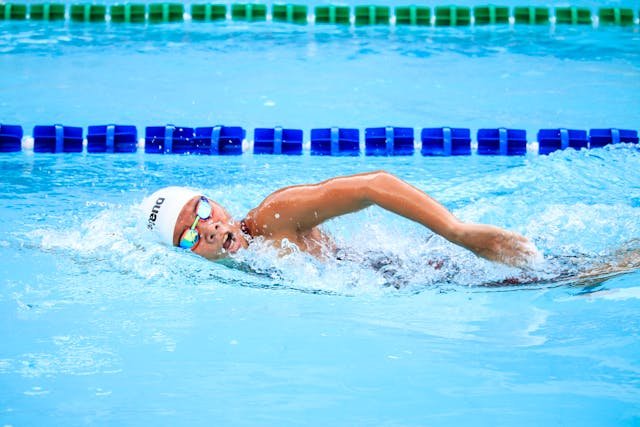
When it comes to swimming, water temperature isn’t just a matter of personal preference—it’s a critical factor for both comfort and safety. Whether you’re taking a relaxing dip, teaching a child to swim, or training for competition, knowing what temperature a swimming pool should be can make all the difference. Too cold, and swimmers risk muscle cramps or hypothermia. Too warm, and the body can overheat, especially during vigorous activity.
This guide explores the ideal swimming pool temperatures for different age groups, activities, and environments. Backed by expert recommendations and health standards, we’ll help you determine what temperature a swimming pool should be to ensure an enjoyable and safe experience for everyone who dives in.
Why Pool Temperature Matters
Pool temperature plays a vital role in ensuring both comfort and safety during swimming. Water that’s too cold can cause muscle stiffness, reduce coordination, and increase the risk of cramps or even hypothermia—especially for children and elderly swimmers. On the other hand, excessively warm water can lead to overheating, fatigue, and dehydration, particularly during strenuous swimming or aquatic workouts. That’s why understanding what temperature a swimming pool should be is essential for every pool owner and swimmer.
Proper water temperature also enhances the swimming experience by helping muscles relax and allowing for smoother movement. For therapeutic or rehabilitation purposes, slightly warmer water is recommended to aid in muscle recovery and joint relief. Whether the pool is used for leisure, training, or therapy, maintaining an appropriate temperature supports physical well-being and encourages frequent, enjoyable use. Ultimately, the right temperature makes the pool a safe, healthy, and inviting environment for all.
What Temperature Should a Swimming Pool Be for General Use?
For general use, the ideal swimming pool temperature typically falls between 78°F and 82°F (25.5°C to 27.7°C). This range offers a balance between comfort and energy efficiency, making it suitable for most recreational swimmers. At these temperatures, the water feels refreshing without being too cold, while still allowing the body to maintain its core temperature during extended swims.
Understanding what temperature a swimming pool should be for general use helps create an enjoyable environment for families, guests, and casual swimmers. Temperatures below 78°F may be too chilly for comfort, especially for younger or less active swimmers, while temperatures above 82°F can feel overly warm and may lead to fatigue during physical activity.
Maintaining this ideal range also supports better circulation and muscle relaxation, making every swim more pleasant. Whether it’s a backyard pool or a community facility, getting the temperature right enhances both safety and satisfaction.
What Temperature Should a Swimming Pool Be for Children and Seniors?
Children and seniors are more sensitive to temperature changes, making it essential to maintain warmer pool conditions for their comfort and safety. The recommended swimming pool temperature for these age groups is typically between 84°F and 88°F (28.8°C to 31°C). At this range, the water is warm enough to prevent chills and muscle stiffness, while still remaining safe for light activity and relaxation.
Understanding what temperature a swimming pool should be for children and seniors helps reduce health risks such as hypothermia, joint pain, and respiratory stress. For young children, especially infants and toddlers, warm water encourages longer and more enjoyable swim sessions. Seniors often benefit from higher temperatures due to reduced circulation and common age-related conditions like arthritis.
By maintaining a consistent, comfortable temperature, pool owners can ensure a welcoming and safe swimming environment that supports physical well-being for both the youngest and oldest swimmers.
What Temperature Should a Swimming Pool Be for Athletes and Training?
For athletes and those engaged in swim training, the ideal pool temperature is slightly cooler, typically ranging between 77°F and 82°F (25°C to 27.7°C). Cooler water helps regulate body heat during intense physical activity, preventing overheating and fatigue. This temperature range also enhances performance by keeping muscles engaged without causing stiffness or shock from cold water.
Knowing what temperature a swimming pool should be for athletes and training is important for optimizing endurance, reducing the risk of injury, and improving recovery. Competitive swimmers, triathletes, and water aerobics participants benefit from this range because it supports higher-intensity movement and allows for longer training sessions without discomfort.
Warmer water can lead to faster exhaustion, while water that’s too cold can reduce flexibility and lead to muscle strain. Maintaining the correct pool temperature for athletic use ensures a safe, controlled environment that enhances training outcomes and promotes physical conditioning.
Seasonal and Regional Considerations
When determining what temperature a swimming pool should be, it’s important to consider both seasonal changes and regional climate. In colder regions or during winter months, maintaining a pool temperature around 82°F to 84°F (27.7°C to 28.8°C) is ideal to counteract chilly ambient conditions and ensure comfort. Warmer climates or summer seasons may allow for slightly lower temperatures, such as 78°F to 80°F (25.5°C to 26.6°C), since external heat helps regulate body temperature during swimming.
Energy costs and heating efficiency also vary by region. In areas with long winters, insulated pool covers and solar heating systems can help maintain warmth without significantly increasing utility bills. Meanwhile, in tropical climates, the challenge may be cooling down overly warm water to avoid overheating.
Adapting to local weather patterns ensures that your pool remains usable and enjoyable throughout the year, making comfort and safety a year-round priority for swimmers of all ages.
Indoor vs. Outdoor Pools: Does Temperature Differ?
Yes, the ideal temperature can differ between indoor and outdoor pools due to environmental factors. Indoor pools are generally easier to regulate and maintain at a consistent temperature, with recommendations typically between 78°F and 82°F (25.5°C to 27.7°C) for general use. Because they’re not exposed to wind, rain, or direct sunlight, indoor pools can offer more controlled comfort regardless of the season.
Outdoor pools, on the other hand, are influenced by weather conditions. In cooler climates or during windy days, swimmers may prefer slightly warmer water—around 82°F to 84°F (27.7°C to 28.8°C)—to offset the external chill. Conversely, in hot, sunny regions, lower temperatures may feel more refreshing and prevent overheating.
Understanding what temperature a swimming pool should be based on its location ensures a better swimming experience. Adjusting accordingly helps maintain comfort, energy efficiency, and safety whether your pool is sheltered indoors or exposed to the elements.
How to Measure and Maintain the Right Temperature
Maintaining the correct water temperature starts with accurate measurement. Use a reliable pool thermometer—digital or analog—to regularly check water temperature. Some advanced pool systems even include built-in temperature sensors that sync with smart devices for real-time monitoring. Knowing what temperature a swimming pool should be is only useful if you consistently measure and adjust accordingly.
To maintain the right temperature, consider investing in a pool heater—gas, electric, or solar—based on your climate and usage. For energy efficiency, use a pool cover when the pool isn’t in use to prevent heat loss, especially overnight or during cooler weather. Insulated covers and solar blankets can significantly reduce heating costs.
Regular maintenance also plays a role. Keep the pool clean and balanced, as debris or imbalanced water chemistry can affect heater performance. With proper tools and habits, you can ensure your swimming pool stays within the ideal temperature range year-round.
Common Myths About Pool Temperature
- “Warmer water is always better”
→ Excessively warm water can lead to overheating, fatigue, and dehydration—especially during physical activity. - “Cold water toughens swimmers”
→ While cold water training exists, it’s not safe or beneficial for all swimmers. It can cause muscle stiffness, cramps, and even hypothermia in some cases. - “Pool temperature doesn’t matter if the air is warm”
→ Air temperature may feel pleasant, but cold water can still shock the body, particularly when diving in or swimming for extended periods. - “Heated pools aren’t necessary in warm climates”
→ Even in hot regions, nighttime temperature drops and seasonal changes can make unheated pools uncomfortable without temperature control. - “You can set one temperature for everyone”
→ Different users—children, seniors, athletes, or casual swimmers—have different comfort and safety needs, requiring tailored temperature settings. - “Solar covers are only for heating”
→ They also help retain heat and reduce evaporation, maintaining consistent water temperature.
Expert Tips for Setting the Ideal Pool Temperature
- Match temperature to pool usage
→ Use 78°F–82°F (25.5°C–27.7°C) for general swimming, 84°F–88°F (28.8°C–31°C) for children/seniors, and 77°F–82°F (25°C–27.7°C) for athletic training. - Adjust for climate and season
→ Raise the temperature in colder months or windy regions; lower it slightly during hot summer days. - Use a smart thermostat or automated system
→ Digital systems can help maintain consistent temperatures and optimize energy use. - Cover your pool when not in use
→ Pool covers reduce heat loss, lower energy costs, and help keep the water temperature stable. - Warm up gradually
→ Avoid sudden temperature changes; increase water temperature slowly to prevent damage to equipment and discomfort for swimmers. - Monitor and maintain regularly
→ Check pool temperature daily and schedule routine maintenance for heaters and sensors. - Consider user health needs
→ Warmer water may benefit those with arthritis or mobility issues; consult with a healthcare professional when in doubt.
FAQs About Swimming Pool Temperature
1. What is the ideal swimming pool temperature for general use?
The recommended range is 78°F to 82°F (25.5°C to 27.7°C), which balances comfort, safety, and energy efficiency for most recreational swimmers.
2. What temperature should a swimming pool be for babies and toddlers?
Pools for infants and toddlers should be warmer, around 85°F to 88°F (29.4°C to 31°C), to keep their bodies warm and prevent chills.
3. Can swimming in cold water be dangerous?
Yes. Cold water can lead to muscle cramps, reduced coordination, hypothermia, and even cold shock if the temperature is too low.
4. What’s the best temperature for lap swimming or training?
For athletic use, 77°F to 82°F (25°C to 27.7°C) is ideal to prevent overheating during vigorous activity.
5. Do indoor and outdoor pools need different temperatures?
Indoor pools are easier to maintain at a stable temperature, while outdoor pools may need seasonal adjustments based on climate.
6. How can I keep my pool at the right temperature?
Use a reliable thermometer, invest in a quality heater, and cover your pool when not in use to retain heat and reduce energy costs.







